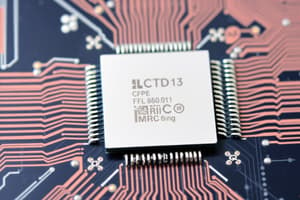Podcast
Questions and Answers
What distinguishes high level languages from low level languages?
What distinguishes high level languages from low level languages?
- High level languages are machine independent. (correct)
- High level languages require extensive hardware knowledge.
- Low level languages use normal English.
- Low level languages are easier to understand.
Which of the following languages is specifically designed for commercial applications?
Which of the following languages is specifically designed for commercial applications?
- COBOL (correct)
- BASIC
- FORTRAN
- C++
What is a key function of a compiler in programming?
What is a key function of a compiler in programming?
- To correct syntax errors in the code.
- To run programs written in low level language.
- To convert high level language into machine language. (correct)
- To execute each instruction one at a time.
How does an interpreter differ from a compiler?
How does an interpreter differ from a compiler?
Which language is NOT categorized as a high level programming language?
Which language is NOT categorized as a high level programming language?
What is the primary function of the Control Unit in a computer system?
What is the primary function of the Control Unit in a computer system?
Which part of the CPU handles arithmetic and logical operations?
Which part of the CPU handles arithmetic and logical operations?
How does primary storage interact with the Arithmetic Logic Unit (ALU)?
How does primary storage interact with the Arithmetic Logic Unit (ALU)?
What distinguishes system software from application software?
What distinguishes system software from application software?
What is the purpose of the output unit in a computer system?
What is the purpose of the output unit in a computer system?
Flashcards are hidden until you start studying
Study Notes
Computer Components and Their Functions
- Retains information without power; used to hold program instructions and data.
- Central Processing Unit (CPU) functions as the brain of the computer, making key decisions and controlling operations.
- CPU consists of two main parts: the Arithmetic Logic Unit (ALU) and the Control Unit.
- Arithmetic Logic Unit (ALU) executes arithmetic and logical operations, handling data stored in primary storage temporarily.
- Control Unit manages data transfers and instructions among other units, coordinating operating functions and communicating with Input/Output devices.
- Output Unit converts coded results from the computer to human-readable formats using devices like monitors and printers.
Hardware and Software
- Computer systems comprise hardware (physical components) and software (commands for hardware).
- Software classified into system software, which runs and manages computer operations, and application software.
- High-Level Languages simplify programming and do not require extensive hardware knowledge, making programming more accessible.
Examples of High-Level Programming Languages
- BASIC: Easy to learn general-purpose language, mainly for microcomputers.
- COBOL: Standardized language for commercial applications.
- FORTRAN: Developed for scientific and mathematical tasks, popular in scientific communities.
- C: Versatile language for diverse applications including scientific, commercial, and game development.
- C++: Object-oriented language used generally.
Programming Language Translators
- Compilers convert high-level language source code into machine language.
- Interpreters execute high-level language statements one at a time, converting each before execution.
- Assemblers translate assembly language into machine language.
- Linkers combine object files generated by compilers into executable files.
Introduction to C Programming
- C, developed in 1972 at Bell Laboratories by Dennis Ritchie, is a structured programming language initially for UNIX implementation.
- ANSI standardized C programming in 1983 to provide a modern definition.
Popularity and Characteristics of C
- C is reliable, simple, portable, and has a vast assortment of operators.
- It allows greater freedom in data storage while not enforcing strict data type checks.
- Dominant in developing applications for minicomputers and personal computers, widely used for systems like word processors and compilers.
Structure and Syntax of a C Program
- C programs must follow a defined structure including header files, main function, and code blocks.
- Example given includes basic input/output operations using the
#includedirective and functions likeprintfandscanf.
Real and Character Constants
- Rules for real constants:
- Must include at least one digit and a decimal point.
- Can be positive or negative, with no commas or blanks.
- Exponential constants are expressed with 'e' for mantissa and exponent separation.
- Character constants consist of single characters within single quotes and can only be one character long.
Variables in C
- Variables are named storage locations for values that can change over time but hold one value at a moment.
- Each variable is associated with a data type (e.g., int, char, float) that defines the possible values.
- Example variable declarations include
int page_no,char grade,float salary, andlong y. - Variables can be declared at the start of a block of code or before function names.
Studying That Suits You
Use AI to generate personalized quizzes and flashcards to suit your learning preferences.



